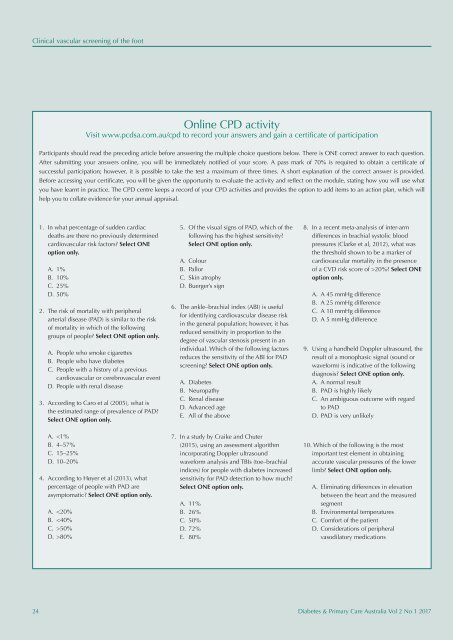DPCA2-1
You also want an ePaper? Increase the reach of your titles
YUMPU automatically turns print PDFs into web optimized ePapers that Google loves.
Clinical vascular screening of the foot<br />
Online CPD activity<br />
Visit www.pcdsa.com.au/cpd to record your answers and gain a certificate of participation<br />
Participants should read the preceding article before answering the multiple choice questions below. There is ONE correct answer to each question.<br />
After submitting your answers online, you will be immediately notified of your score. A pass mark of 70% is required to obtain a certificate of<br />
successful participation; however, it is possible to take the test a maximum of three times. A short explanation of the correct answer is provided.<br />
Before accessing your certificate, you will be given the opportunity to evaluate the activity and reflect on the module, stating how you will use what<br />
you have learnt in practice. The CPD centre keeps a record of your CPD activities and provides the option to add items to an action plan, which will<br />
help you to collate evidence for your annual appraisal.<br />
1. In what percentage of sudden cardiac<br />
deaths are there no previously determined<br />
cardiovascular risk factors? Select ONE<br />
option only.<br />
A. 1%<br />
B. 10%<br />
C. 25%<br />
D. 50%<br />
2. The risk of mortality with peripheral<br />
arterial disease (PAD) is similar to the risk<br />
of mortality in which of the following<br />
groups of people? Select ONE option only.<br />
A. People who smoke cigarettes<br />
B. People who have diabetes<br />
C. People with a history of a previous<br />
cardiovascular or cerebrovascular event<br />
D. People with renal disease<br />
3. According to Caro et al (2005), what is<br />
the estimated range of prevalence of PAD?<br />
Select ONE option only.<br />
5. Of the visual signs of PAD, which of the<br />
following has the highest sensitivity?<br />
Select ONE option only.<br />
A. Colour<br />
B. Pallor<br />
C. Skin atrophy<br />
D. Buerger’s sign<br />
6. The ankle–brachial index (ABI) is useful<br />
for identifying cardiovascular disease risk<br />
in the general population; however, it has<br />
reduced sensitivity in proportion to the<br />
degree of vascular stenosis present in an<br />
individual. Which of the following factors<br />
reduces the sensitivity of the ABI for PAD<br />
screening? Select ONE option only.<br />
A. Diabetes<br />
B. Neuropathy<br />
C. Renal disease<br />
D. Advanced age<br />
E. All of the above<br />
8. In a recent meta-analysis of inter-arm<br />
differences in brachial systolic blood<br />
pressures (Clarke et al, 2012), what was<br />
the threshold shown to be a marker of<br />
cardiovascular mortality in the presence<br />
of a CVD risk score of >20%? Select ONE<br />
option only.<br />
A. A 45 mmHg difference<br />
B. A 25 mmHg difference<br />
C. A 10 mmHg difference<br />
D. A 5 mmHg difference<br />
9. Using a handheld Doppler ultrasound, the<br />
result of a monophasic signal (sound or<br />
waveform) is indicative of the following<br />
diagnosis? Select ONE option only.<br />
A. A normal result<br />
B. PAD is highly likely<br />
C. An ambiguous outcome with regard<br />
to PAD<br />
D. PAD is very unlikely<br />
A.
















